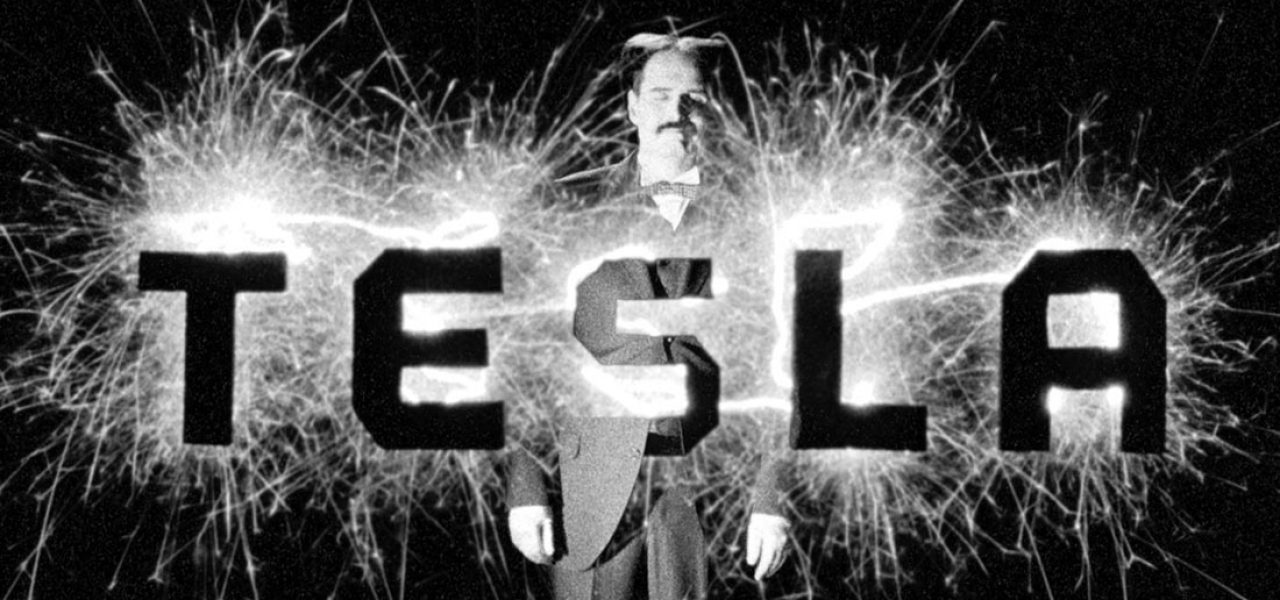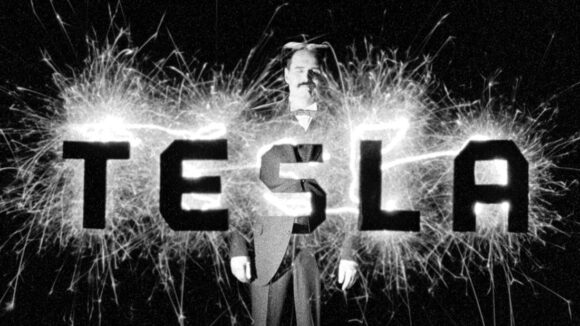

It’s Hard to Be A Utopian: Matthew Rankin On His New Film ‘The Tesla World Light’
Matthew Rankin is a filmmaker of emotional impact. It is a particular gift, given that much of his work is rooted in history and communicated through abstraction.

His latest exploration with the National Film Board of Canada, The Tesla World Light, premiered today at the 56th International Critics’ Week, a parallel section of the Cannes Film Festival organized by the French Syndicate of Film Critics.
The film experiments with light painting to explain the last years of Nikola Tesla, the utopian scientist whose vision of free energy, incongruous with 20th century capitalism, led to a love affair with a pigeon as well as a penniless death. It’s a surreal, seamless merge of long-exposure animation, historical accuracy, and abstract art.
It’s also another moving example of the impactful mark that Matthew Rankin can make, in a few minutes using fewer materials than many. His last historical short, Mynarski Death Plummet, packed an emotional punch using a synesthetic technique which The Tesla World Light electrically replicates.
“I think of my style, such as it is, as a synthesizing,” Rankin explained to Cartoon Brew by phone. “Mynarski Death Plummet used hand processing to tell a story. The Tesla World Light does the same using early 20th century avant-garde abstraction. I like using the vocabulary of abstract art and animation for a narrative purpose.”
While his previous shorts, like the rapid-fire Cattle Call (co-directed with Mike Maryniuk) and the NFB-produced The Radical Expeditions of Walter Boudreau, played with the fringes of sound, The Tesla World Light hits you right in the eyes with light. Its history, its technique, and its utopian promise, which remain topical for times as deeply troubled as ours.
Cartoon Brew: Your Twitter bio says you live somewhere between slapstick and utopia, which seems fitting because Nikola Tesla was something of a slapstick utopian.
Matthew Rankin: There’s something very romantic about Tesla. He was an idealistic scientist and he was convinced what he was doing was going to save the world. He had a grandiose vision of the future, as did many early 20th century utopians. But I think Tesla ranks among the most grandiose.
Of course, that coexists with other facets of Tesla. There is a photograph of him reading a book, as electric thunderbolts fire around him. There is an element of the absurd in Tesla, and I like that contrast.

Your film begins with Tesla on his deathbed, begging for a loan from J.P. Morgan. Today, Elon Musk’s company named for Tesla is scaling up solarized electrification. What do you think Tesla would say about this embrace of his vision?
Matthew Rankin: It’s interesting, because Tesla himself wasn’t that into business, insofar that it could fund his work. He had so many ideas, and he had to get them all out, as people grew impatient with him. And not only that, he was idealistic that energy and electricity could be free for everyone on the planet, which is at odds with the capitalist imperative. Of course, a giant company called Tesla today is somewhat ironic, but at the same time, if I understand the operation, its long-term goal is to reduce dependence on fossil fuels to take back electricity. That is a great homage to Nikola Tesla; it is a way of asserting human freedom through energy.
And those are Tesla’s actual letters; everything in the film is drawn from something he wrote or said. The letters to Morgan are absolutely fascinating; I found them in the Library of Congress. They’re much longer and more detailed than what is in the film, but they are beautiful, poetic, heartbreaking, soul-withering, desperate pleas for help. You see that he has all these ideas, but the world is just not interested. It is very beautiful and sad, and reminds me very much of abstract art. I feel like there is a certain similitude between an abstract futurist like Tesla and his contemporaries in the art world.
How did you use Tesla’s history as a launch window into your abstract technique?
Matthew Rankin: It’s about trying to engage in feeling and texture. There is so much about the human experience that resists the historical record, because there is only so much of the past that you can measure and record. So the vocation of the historian is somewhat bereft of this information. What is the history of our most extreme emotions? How can this be documented? That is more the vocation of the artist than the historian, so I try to get at the abstract feelings that may have inhabited the past. Of course, it’s an imaginative engagement. It’s my interpretation.
You chose to play with light to illuminate a scientist who saw, and felt, light like few others.
Matthew Rankin: Light was our raw material. I had done a bit of experimentation with light painting, which is a great technique I associate with experimental photography. You open the exposure and move the light through. Adapting it to animation was very hard but really fun; I think I burned through 15,000 sparklers in the process of making this film. We also used fluorescent lamps, flashlights, light-emitting diodes, and more. There is a shot of Tesla reading in front of his Tesla coil, which is breathing and vibrating with light, that we made using a constructed windmill with a row of lights that could be changed and moved. We spun the windmill while the exposure was open, which created brilliant rings of light.
The inspiration for much of this is an unbelievable photographic archive of Tesla, most of which use these long exposures and silver emulsions. And, of course, the thing about shooting on 16-millimeter film is that it is light. What you are actually having is an encounter with light, rather than an encounter with numbers. When you see black, it is an absence of light, not more numbers.
You’ve spoken about using formalism for abstract art, but its handmade imperfection mirrors Tesla’s vision, which was incongruous with his period.
Matthew Rankin: It’s tricky, because we live in an age that has been described as anti-utopian. Utopian visions of the future, which were so much a part of how people encountered their world at the beginning of the 20th century, have all but vanished. They’ve all kind of fallen apart, although there are some that have been hanging on. But I think it’s a hard era in which to be a utopian. I have a lot of idealistic longing, but I don’t have a great deal of idealistic conviction. I think there is a difference.

What about Tesla’s conviction that he had fallen in love with a pigeon?
Matthew Rankin: That was based on an interview Tesla gave; he really did say it. The climactic scene when the bird explodes with electricity is my interpretation of what Tesla himself described as the bird’s death. He said a light, more powerful than any he had ever created in his laboratory, started to burst out of the bird’s eyeballs. The interview was conducted near the end of Tesla’s life, when he was kind of unstable, so one can imagine his testimony was given through that prism. But I choose to believe it, and I tried to play it as earnest as I could.
It has a comic but historical weight, given its basis in testimony. It also gives you more room to play with symbolism and light.
Matthew Rankin: That’s true. The other light that plays a role in this, according to my own diagnosis, is that Tesla probably had a form of synesthesia, which is where your encounters with the world become visually manifest. Tesla claimed that when he experienced extreme emotions like love, fear, and shock, his eyes would become filled with abstract, luminous forms. The film plays with that.

He’s a great subject for you, because your work has that synesthetic impact, which makes it distinctive. I can quickly tell if I’m watching a Matthew Rankin film.
Matthew Rankin: I feel like I live with many cinematic ghosts, hovering over everything that I do. I think of my style, such as it is, as a synthesizing. My last film, Mynarski Death Plummet, used hand processing to tell a story; The Tesla World Light does the same using early 20th century avant-garde abstraction. I like using the vocabulary of abstract art and animation for a narrative purpose. I love experimental film, but I also have a desire to build characters and create emotions.
So my work is about seeing how far I can go to tell a story through the prism of visual abstraction. I do think that visual language can have enormous emotional power. I don’t want to say that it can too often be confined or limited by pure formalism, which I also love, but I do want to explore how much emotional information I can infuse.
So how do you follow a short about a dying scientist in love with an electric bird?
Matthew Rankin: I just shot a feature film called The 20th Century, which is a historical live-action drama about a former prime minister of Canada who fell in love with a shoe. [Laughs] I’m moving on to inanimate objects.

